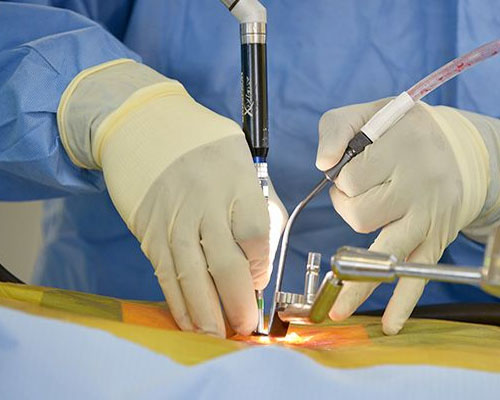Minimally Invasive Spine Surgery - By Dr. Pravin Ganjre
In common, the purpose of minimally invasive spine surgery (MIS) surgery is to maintain the vertebral bones and spinal segments and/or relieve the pressure being applied to the spinal tissues — usually a result of conditions such as spinal weakness, bone spurs, herniated discs, scoliosis or spinal tumors.
As denied to open spine surgery, minimally invasive surgical procedures can be quicker, more secured and need less healing time. Because of the decreased trauma to the soft tissues and muscles.

The possible advantages are:
- Better cosmetic results from fewer skin cuts
- Less blood loss from operation
- Decreased chance of muscle loss since less or no cutting of the muscle is required.
- Reduced chance of infection and postoperative pain.
- Quicker healing from surgery and shorter rehabilitation required.
- Reduced dependence on pain medications after surgery.
Also, some MIS surgeries are done as outpatient procedures and utilize only local anesthesia — so there is less risk for an adverse reaction to general anesthesia.
As with any surgical method, no matter how minimal, there are certain dangers connected that include but are not limited to:
- Potential adverse reaction to the anesthetic
- Unexpected blood loss during the method
Localized infections, no matter how little the hole section. And, though rare, there is always a little chance that the first MIS surgery cannot be completed, requiring either a 2nd procedure or full open surgery.
Which spinal conditions can be treated with minimally invasive spine surgery (MISS)?
Surgery of the spine can often be performed through either an open surgical approach or a minimally invasive approach. Not all types of spine surgery can be done with MISS.
The following type of conditions can be treated with MISS.
- Herniated disc
- Spinal stenosis (narrowing of the spinal canal)
- Spinal deformities (like scoliosis)
- Spinal instability
- Spondylolysis (a defect in a part of lower vertebrae)
- Fractured vertebra
- Removal of a tumor in the spine
- Infection in the spine
Why minimally invasive spine surgery is better than trasitional spine surgery?
Minimally invasive surgery has been shown to offer the patient:
- Less overall stress
- Shorter hospital stays
- Less postoperative painLess blood loss
- Smaller scars
- Less damage to muscle and skin
- Faster and easier rehabilitation
- Quicker return to normal activities
How minimally invasive spine surgery is performed?
With the Minimally Invasive option, the Neurosurgeon uses multiple small incisions rather than the traditional long midline incision of open surgery, and the surgeon splits (spreads) muscle fibers rather than strips them away from the bone. As a result, hospital stays may be shorter.X-ray guidance (fluoroscopy) is used much more intensively during Minimally Invasive procedures on the Spine.
With large open incisions, the surgeon can expose much of the spinal anatomy and use anatomical features as a reference for guidance. With Minimally Invasive approaches, the spine surgeon arrives at certain points in the spine through very small skin incisions guided significantly by the use of live x-ray imaging in the operating room. Minimally Invasive fusions can also be accomplished with the use of extensive live x-ray imaging in the operating room. The C arm is an x-ray device which allows the surgeon to see, in real time, where his instruments are going relative to the Spine. Pedicle screws can be placed into the Spine using this technique.
Many instrument sets have been designed to facilitate Minimally Invasive fusions. One such example is the Sextant device, which allows the spine surgeon to first place screws into the pedicles of the Spine, then attach a device to the screws which helps the surgeon tunnel a rod through a small opening in the skin, and cast the rod through the screws inserted into the Spine, thus allowing for very stable construct.
As technology advances, the options for approaches to the Spine increase. The skilled Spine Surgeon can advise which situations are treatable with a Minimally Invasive approach and which are best treated with a more open approach.
What are the risks associated with it?
Like traditional open surgeries, Minimally Invasive surgery has risks as well. Although the outside incision is different, the same type of procedure is usually performed on the inside with most Minimally Invasive surgeries, resulting in possible risks to the nerves in the area.
The risks of minimally invasive spine surgery include:
-
- Infection
- Excess bleeding
- Pain at the graft site
- Nerve damage
- Blood clots
- Complications from anesthesia
- Leaking of spinal fluid. This may cause headaches or other problems.
- Not enough relief of your back pain
What is Postoperative Care for minimally invasive spine surgery?
The postoperative care in a hospital after a Minimally Invasive Approach to the spine is often shorter than that with an open approach.
- Maintain good wound care, keeping the wound dry for 10 to 12 days.
- Patients with lumbar surgeries and neck surgery should avoid significant straining, bending, twisting, or lifting.
- The imposition of restrictions will vary depending upon the type of surgery.
Who is the best minimally invasive spine surgeon in Pune?
Dr. Dilip Kiyawat is the most reliable Minimally Invasive Spine Surgeon in Pune. He has gained years of experience in this field. He has wide experience in working in various fields of Neurosurgery like Brain Trauma, Spine Trauma, Pediatric Neurosurgery, Brain and Spine Tumors, and Surgeries for Back Pain, etc. He has also experience in Stem Cell Therapy in various Neurological conditions. He is a Panel Consultant of Ruby Hall Clinic and Poona Hospital.
